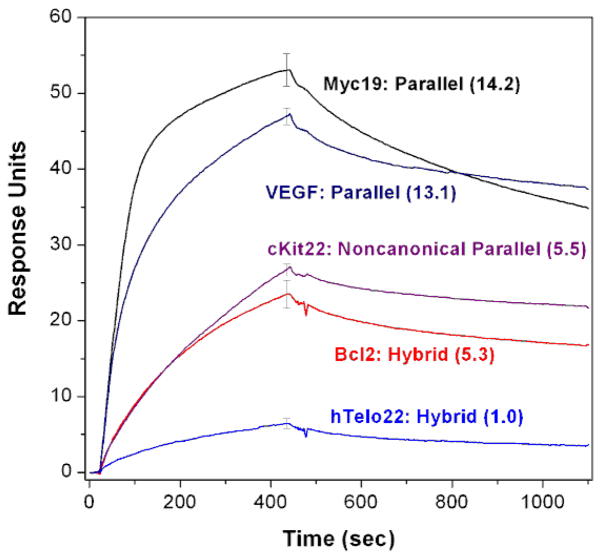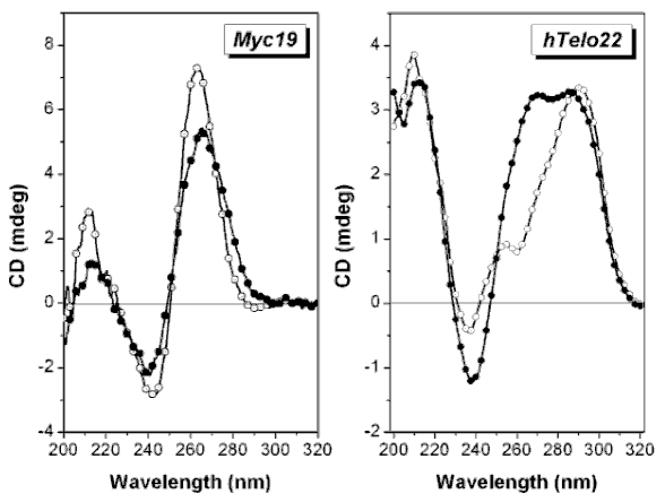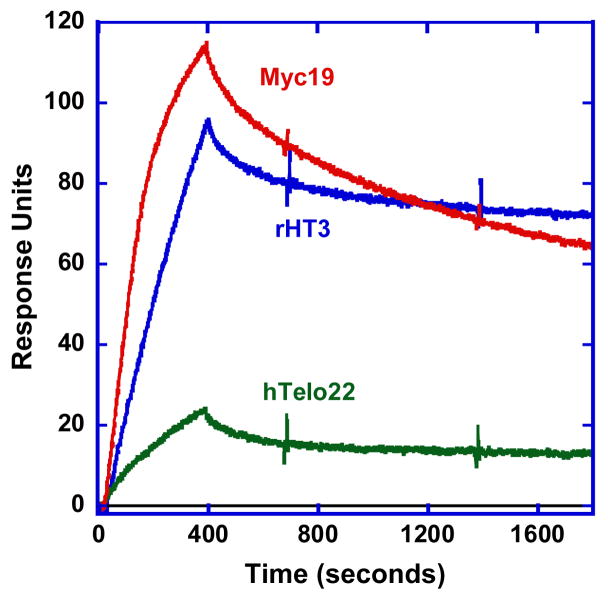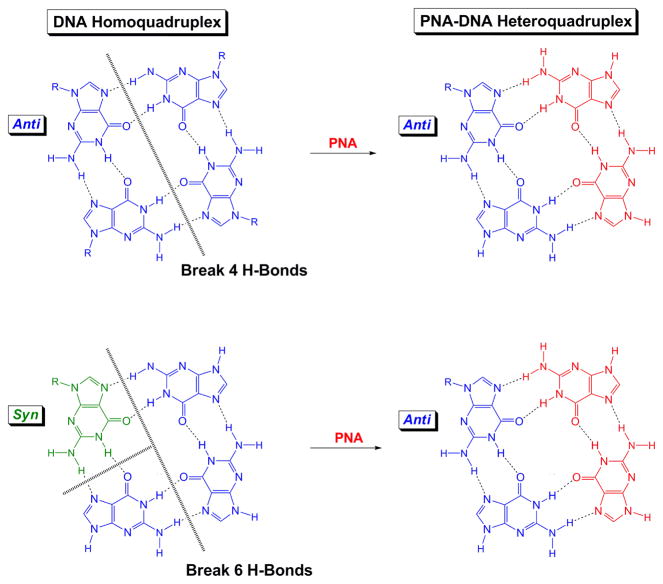Abstract
Guanine-rich peptide nucleic acid probes hybridize to DNA G quadruplex targets with high affinity, forming PNA-DNA heteroquadruplexes. We report a surprising degree of kinetic discrimination for PNA heteroquadruplex formation with a series of DNA targets. The fastest hybridization is observed for targets folded into parallel morphologies.
DNA and RNA guanine quadruplex motifs are the subject of increasing attention due to their suspected roles in regulating transcription, RNA splicing and translation, telomere length and chromosome stability. A variety of strategies are being developed for targeting G-quadruplexes with synthetic compounds, since such reagents would be useful probes of biological function and potential therapeutics. Our labs have adopted a sequence-targeted approach involving peptide nucleic acid (PNA) oligomers that bind with high affinity to quadruplex-forming sequences (QFSs). Rather than using a cytosine-rich PNA to bind to the QFS via Watson-Crick base pairing1–3, our PNAs are G-rich and bind to both DNA4,5 and RNA6,7 QFSs via G-tetrad formation, yielding heteroquadruplexes with low nanomolar dissociation constants. The PNAs typically consist of two Gn tracts, allowing them to bind to a quadruplex target, which has at least four Gn tracts, in a 2:1 stoichiometry.5,7 Our group and others have shown that a variety of backbone modifications8, 9 or the addition of a stacking ligand10 provide additional opportunities for enhancing the quadruplex binding affinity and/or selectivity of G-rich PNAs.
Based on our earlier results, we were motivated to investigate hybridization of the PNA to a variety of other DNA quadruplexes in order to define the scope of possible targets that could be recognized by this binding mode. Table S1 lists the sequences that were studied; Myc19 was the subject of our earlier reports and was included for comparison with the new targets. The VEGF, cKIT22 and Bcl2 quadruplexes are derived from oncogene promoter sequences, while hTelo22 is based on the human telomeric repeat sequence (GGGTTA)n. All five of these quadruplexes consist of three stacked G tetrads, but exhibit considerable variation in the morphology, as determined by multidimensional NMR spectroscopy and/or circular dichroism spectroscopy.11–16
We used our previously reported quadruplex-forming PNA probe Pmyc (H-GGGAGGGG-LysNH2) for our initial experiments. Figure 1 shows the results of surface plasmon resonance (SPR) experiments in which the various DNA targets were immobilized on a streptavidin-coated carboxymethyl-dextran chip while the PNA was allowed to flow over the surface of the chip. A surprising degree of kinetic discrimination is observed in the SPR sensorgrams. The fastest hybridization occurs for the Myc19 and VEGF quadruplexes, with intermediate on-rates observed for cKit22 and Bcl2. By far the slowest hybridization is observed for the telomeric quadruplex hTelo22, although we note that the relatively small amount of PNA that binds to this target is also slow to dissociate.
Fig. 1.
SPR sensorgrams for hybridization of Pmyc (10 nM) to immobilized DNA quadruplex targets. Vertical error bars reflect standard deviations for three separate experiments. Numbers in parentheses indicate initial rates of association, relative to hTelo22.
Based on the SPR results, we selected the most disparate targets, Myc19 and hTelo22 for further study. To determine whether the kinetic discrimination between these two targets was specific to Pmyc, we performed SPR experiments with two other PNAs, Ptelo (H-GGGTTAGGG-LysNH2) and Peg2 (H-GGG-eg2-GGG-LysNH2, where eg corresponds to an abasic spacer residue9). As shown in supporting information, both of these PNAs bound much faster to Myc19 than to hTelo22 (Fig. S1), indicating that the kinetic advantage in targeting Myc19 is due to an inherent property of the DNA quadruplex, not the PNA probe.
UV melting curves for the two DNA quadruplexes alone and in the presence of Pmyc are shown in Figure 2. Two equivalents of the PNA were used in both cases based on the expected stoichiometries of the heteroquadruplexes5,9 and a low KCl concentration (1 mM) was used to allow observation of all melting transitions. The hTelo22 homoquadruplex melts at significantly lower temperature than the Myc19 homoquadruplex. Melting of the corresponding heteroquadruplexes occurs at much higher temperatures, with ΔTm = 24.9 °C and 17.4 °C for hTelo22 and Myc19, respectively. The heteroquadruplexes were destabilized by > 10 °C when KCl was replaced by LiCl, as expected for structures stabilized by G-tetrads (data not shown).
Fig. 2.
UV melting curves recorded for 1.0 μM Myc19 (left) and hTelo22 (right) with and without 2 equiv Pmyc. Data were normalized to the A295 value at 15 °C.
Circular dichroism spectroscopy provided additional insight into the differences in hybridization of Pmyc to the two DNA quadruplexes. As shown in Figure 3, Myc19 exhibits positive and negative extrema at 260 nm and 240 nm, respectively, and these features are retained upon PNA hybridization, consistent with our earlier reports. hTelo22 alone exhibits a peak at 295 nm with a weaker shoulder at 260 nm, as expected for the “hybrid” folded structure of this quadruplex, which contains a mixture of parallel and antiparallel strand orientations.16 When the PNA is present, the 295 nm peak is maintained, but the 260 nm peak grows to be nearly equal in intensity. Thus, the structure of the heteroquadruplex appears to contain a mixture of parallel and antiparallel features, although there is perhaps a shift in favor of parallel strand orientations.
Fig. 3.
Circular dichroism spectra recorded for 1.0 μM Myc19 (left) and hTelo22 (right) with and without 2 equiv Pmyc. Samples contained 100 mM KCl. Open circles: DNA alone; filled circles: DNA + PNA.
The results shown in Figure 1 indicate that heteroquadruplex formation by Pmyc occurs fastest for the purely parallel targets, Myc19 and VEGF, while the noncanonical parallel structure of cKit22, in which one of the G3 tracts is formed by a noncontiguous set of guanines, and the two hybrid quadruplexes, are less easily invaded by the PNA. Based on these observations, we decided to investigate one additional quadruplex target, rHT3 (Table S1). This chimeric molecule has the same sequence as hTelo22 but features two G3 tracts based on ribonucleotides while the remaining G3 tracts (and loops) retain deoxyribonucleotides. Shafer previously demonstrated that rHT3 exhibits a CD spectrum reminiscent of Myc19, suggesting that rHT3 adopts a parallel conformation rather than the hybrid structure of hTelo22.17 The parallel CD spectrum of rHT3 is preserved in the presence of Pmyc (Figure S2). As shown in Figure 4, Pmyc hybridizes much faster to rHT3 than to hTelo22, consistent with a kinetic preference for hybridizing parallel quadruplex structures.
Fig. 4.
SPR sensorgrams for hybridization of Pmyc (40 nM) to immobilized Myc19, rHT3 and hTelo22 quadruplexes.
Our previous experiments revealed that Pmyc binds to Myc19 with a 2:1 stoichiometry and an average Kd = 5.0 nM, as determined by a competition SPR method that allows analysis of heteroquadruplex formation in solution.5 We used the same method to analyze binding of Pmyc to hTelo22 and rHT3 and again found that the data were well fit by a 2:1 equivalent site binding model, with an average Kd = 12.5 nM and 0.7 nM, respectively (Figures S3–S6). Thus, the much slower association rate for hTelo22 relative to Myc19 is almost completely offset by slower dissociation kinetics, resulting in Kd values that differ by only a factor of 2.5. Meanwhile, the significantly lower Kd for the chimeric quadruplex rHT3 represents the first sub-nanomolar Kd we have determined for PNA-containing heteroquadruplexes.
Further experiments are required to understand the wide range of hybridization kinetics shown in Figures 1 and 4. While our strategy exhibits some level of sequence selectivity, which can be tuned by varying the PNA backbone and loop composition,9 the kinetic data suggest possible structure selectivity as well. An interesting distinction within the set of five DNA quadruplexes targeted in Figure 1 concerns the deoxyguanosine (dG) nucleoside conformations: for Myc19 and VEGF, all of the dGs adopt the anti conformation, whereas the hTelo22 and cKit22 quadruplexes feature a mixture of syn and anti conformations. Whether this difference contributes to the kinetic selectivity remains to be seen, but we can speculate on how this might play a role. The CD data indicate that PNA-DNA heteroquadruplexes favor anti dG conformations, since the spectrum of Myc19 is unchanged by the PNA, while the spectrum of hTelo22 exhibits an enhanced signal at 260 nm. If there is indeed a preference for the anti conformation, then this could account for the slower PNA hybridization to the hybrid and noncanonical parallel targets. As shown in Scheme 1, PNA invasion of a quadruplex in which all of the dGs are anti requires severing only 4 of the 8 hydrogen bonds per G tetrad, since this allows the quadruplex to open (like a book), creating two binding surfaces for the PNAs. In contrast, if a dG is in a syn conformation, then severing 6 hydrogen bonds might be needed to allow the guanine rotation needed to convert from syn to anti prior to PNA hybridization. This model is supported by Shafer’s findings that ribo-substitutions favor anti conformations,17, 18 as in the case of rHT3, which exhibited much faster PNA hybridization kinetics than the isosequential hybrid quadruplex hTelo22.
Scheme 1.
Comparison of PNA-DNA heteroquadruplex formation involving targets containing all anti or anti/syn nucleoside conformations
Conclusions
DNA and RNA recognition by heteroquadruplex formation offers distinctive opportunities for recognition of G-rich sequence and structural motifs. While thermodynamic selectivity has been tuned through variation of the PNA structure, this is the first example of kinetic discrimination among different quadruplex targets. Of course, the preferences observed in these experiments might not carry over to cellular contexts, where protein binding and alternative secondary/tertiary structures could interfere with PNA hybridization. Nevertheless, the results do indicate that parallel structures offer an inherently more accessible target. Recent work indicates that sequences capable of forming parallel quadruplexes are prevalent in the genome19,20 and could provide a rich array of binding sites for a quadruplex-forming PNA.
Supplementary Material
Acknowledgments
The authors thank the United States National Institutes of Health for support of this research (R01 GM58547 to BAA and R01 AI064200 to WDW). KJZ acknowledges support from a U.S. DoD Air Force Office of Scientific Research NDSEG Fellowship 32 CFR 168a. SPR instrumentation was purchased with support from NSF MRI award 0821296.
Footnotes
Electronic Supplementary Information (ESI) available: PNA synthesis details and supporting SPR and CD data.
Notes and references
- 1.Green JJ, Ying L, Klenerman D, Balasubramanian S. J Am Chem Soc. 2003;125:3763–3767. doi: 10.1021/ja029149w. [DOI] [PubMed] [Google Scholar]
- 2.Datta B, Armitage BA. J Am Chem Soc. 2001;123:9612–9619. doi: 10.1021/ja016204c. [DOI] [PubMed] [Google Scholar]
- 3.Amato J, Oliviero G, De Pauw E, Gabelica V. Biopolymers. 2009;91:244–255. doi: 10.1002/bip.21124. [DOI] [PubMed] [Google Scholar]
- 4.Datta B, Schmitt C, Armitage BA. J Am Chem Soc. 2003;125:4111–4118. doi: 10.1021/ja028323d. [DOI] [PubMed] [Google Scholar]
- 5.Roy S, Tanious F, Wilson WD, Ly DH, Armitage BA. Biochemistry. 2007;46:10433–10443. doi: 10.1021/bi700854r. [DOI] [PubMed] [Google Scholar]
- 6.Marin VL, Armitage BA. J Am Chem Soc. 2005;127:8032–8033. doi: 10.1021/ja051102y. [DOI] [PubMed] [Google Scholar]
- 7.Marin VL, Armitage BA. Biochemistry. 2006;45:1745–1754. doi: 10.1021/bi051831q. [DOI] [PMC free article] [PubMed] [Google Scholar]
- 8.Englund EA, Xu Q, Witschi MA, Appella DH. J Am Chem Soc. 2006;128:16456–16457. doi: 10.1021/ja064317w. [DOI] [PubMed] [Google Scholar]
- 9.Lusvarghi S, Murphy CT, Roy S, Tanious FA, Sacui I, Wilson WD, Ly DH, Armitage BA. J Am Chem Soc. 2009;131:18415–18424. doi: 10.1021/ja907250j. [DOI] [PMC free article] [PubMed] [Google Scholar]
- 10.Paul A, Sengupta P, Krishnan Y, Ladame S. Chem Eur J. 2008;14:8682–8689. doi: 10.1002/chem.200800605. [DOI] [PubMed] [Google Scholar]
- 11.Ambrus A, Chen D, Dai J, Jones RA, Yang D. Biochemistry. 2005;44:2048–2058. doi: 10.1021/bi048242p. [DOI] [PubMed] [Google Scholar]
- 12.Phan AT, Modi YS, Patel DJ. J Am Chem Soc. 2004;126:8710–8716. doi: 10.1021/ja048805k. [DOI] [PMC free article] [PubMed] [Google Scholar]
- 13.Sun D, Liu WJ, Guo K, Rusche JJ, Ebbinghaus S, Gokhale V, Hurley LH. Mol Cancer Ther. 2008;7:880–889. doi: 10.1158/1535-7163.MCT-07-2119. [DOI] [PMC free article] [PubMed] [Google Scholar]
- 14.Phan AT, Kuryavi V, Burge S, Neidle S, Patel DJ. J Am Chem Soc. 2007;129:4386–4392. doi: 10.1021/ja068739h. [DOI] [PMC free article] [PubMed] [Google Scholar]
- 15.Dai J, Dexheimer TS, Chen D, Carver M, Ambrus A, Jones RA, Yang D. J Am Chem Soc. 2006;128:1096–1098. doi: 10.1021/ja055636a. [DOI] [PMC free article] [PubMed] [Google Scholar]
- 16.Ambrus A, Chen D, Dai J, Bialis T, Jones RA, Yang D. Nucleic Acids Res. 2006;34:2723–2735. doi: 10.1093/nar/gkl348. [DOI] [PMC free article] [PubMed] [Google Scholar]
- 17.Qi J, Shafer RH. Biochemistry. 2007;46:7599–7606. doi: 10.1021/bi602392u. [DOI] [PubMed] [Google Scholar]
- 18.Tang CF, Shafer RH. J Am Chem Soc. 2006;128:5966–5973. doi: 10.1021/ja0603958. [DOI] [PMC free article] [PubMed] [Google Scholar]
- 19.Huppert J, Balasubramanian S. Nucleic Acids Res. 2008;35:406–413. doi: 10.1093/nar/gkl1057. [DOI] [PMC free article] [PubMed] [Google Scholar]
- 20.Bugaut A, Balasubramanian S. Biochemistry. 2008;47:689–697. doi: 10.1021/bi701873c. [DOI] [PMC free article] [PubMed] [Google Scholar]
Associated Data
This section collects any data citations, data availability statements, or supplementary materials included in this article.







